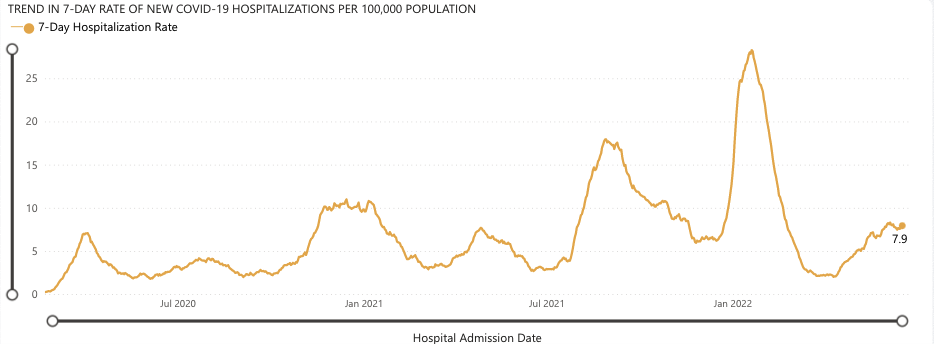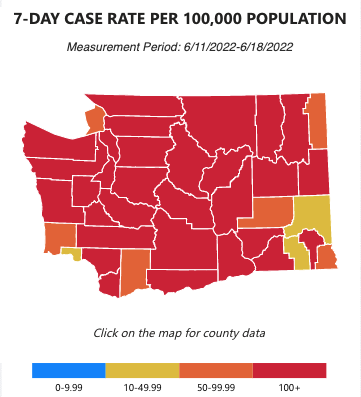
This was our first ‘grab bag’ newsletter, giving you an overview of the most interesting and relevant COVID updates from the past two weeks (as opposed to honing in on one topic). Let us know through the button below if you like it, and we can plan for future ones! The same goes for any of those lingering COVID-related questions, so that we can plan to provide you with answers.
📊 Washington’s COVID-19 Weekly Snapshot
COVID cases 😷
Hospitalization rates 🏥

Last Endemic, we said we’d likely see the current wave plateau. Well, that’s exactly what’s happening: Washington’s current wave that began as Omicron BA.2.12.1 is now plateauing instead of falling due to the rise of more infectious variants, BA.4 and BA.5. Washington’s data mirrors the national data in confirming a plateau.
A plateau is certainly better than a rising wave, but it’s not great and still puts significant stress on our hospitals and on our most vulnerable neighbors. With July 4th around the corner, there’s a risk this plateau could switch to a rise if we don’t take reasonable steps to avoid spreading COVID!
We wish anyone celebrating a wonderful and merry time. But holidays are a lot more enjoyable when you and your loved ones don’t get sick!
Best practices are:
- Celebrate outside and in well-ventilated areas (think lots of open windows and routes for air flow) as much as possible
- Consider getting tested before gathering with family, especially if you have relatives at higher risk from COVID
- Wear a mask in crowded indoor areas
- Get a booster shot if you haven’t already
- If you’re sick, stay home! If you or someone you know is at-risk and tests positive for COVID, don’t delay starting a Paxlovid treatment!
🛍 Our first grab bag edition
Vaccines are really, really effective. A study published last week in The Lancet Journal of Infectious Diseases determined that vaccinations prevented 19.8 million deaths worldwide in only the first year of vaccinations in the pandemic.
Washington’s Chief Science Officer Tao Sheng Kwan-Gett shared in a recent COVID press briefing that over 1,760 Washington children (ages 0-17) were hospitalized due to COVID since the start of the pandemic. 16 of these hospitalizations resulted in deaths.
But last week, vaccines were finally approved for kids under 5!!! Get the youngins their jab! The above press conference also shared that Washington officials are focused on vaccinating the newly-eligible youths, ages 6 months to 4 years old, with the recently-approved Moderna and Pfizer vaccines.
The first person to get COVID from a cat was just reported by Thailand. Watch out for those tabbies! (Mostly joking; This is extremely rare.)
Unfortunately, the Federal Drug Administration (FDA) is struggling with a plan for fall vaccinations. The immunity provided from the first round of vaccines is waning. Scientists also expect fall to be a period with more COVID transmission as people stay indoors, so we’re going to need some new vaccines. But, as Axios reports, the FDA is largely stuck on a timeframe plan and deciding which variants to develop a vaccine from. Right now, they’re leaning toward October or November. We can only hope the vaccines arrive in time…
In other news, scientists are closer to understanding what causes Long COVID. A recent article in Science goes over the top three working theories for what causes Long COVID: tiny blood clots, lingering virus, and a “haywire” immune system that can’t reset to normal.
That’s all folks. Hope you stay safe and set aside some time in July for joy, whatever that looks like for you!
🙏 COVID-19 Resources
- Order 8 free, at-home COVID tests (It doesn’t matter if you’ve placed a previous order through the same site.)
- Order 4 free at-home COVID tests (note: any single address can only be used one time)
- Additional option to order free at-home COVID tests (WA only)
- Find vaccines near you
- Testing locations
What do you think? Have any questions? Tweet us your thoughts @WACommAlliance.
Keep up on Washington’s latest COVID-19 trends, new research, and more through our Endemic newsletter.


